“This was not the tourist season, and in any case the island to which we were bound was no longer an attraction for tourists”
— Graham Greene, The Comedians
As we puttered along in the bumper-to-bumper Port-au-Prince traffic, rolling over occasional streams of raw sewage, Saíntil explained to us that his favorite actor was Shaquille O’Neal. He particularly liked Shaq in the movie Steel.
Saíntil made a quick shortcut through a dodgy alley and we passed a mangy, rabid dog fighting with an enormous pig — literally paw and snout — over the right to eat a pile of garbage. After the shortcut, we were back to a standstill, surrounded by the vibrant reds and blues and yellows of the crazy tap-taps carrying sardined passengers in the overcrowded streets, windshields emblazoned with “Christ Is The Big Captain,” “Lamentations 3:26,” and “Sylvester Stallone.”
As we pondered Shaquille O’Neal’s thespian work, Saíntil surprised us again by saying he often longed for a day when Papa Doc Duvalier — with his voodoo mysticism and his dreaded secret police, the murderous Tontons Macoutes — would be returned to power and end the utter chaos and lawlessness. Saíntil said this even though, at 49, he was certainly old enough to remember first-hand the violence of the Duvalier regime. “Many people believe that Papa Doc is still alive,” he said. “No one actually saw him buried in his coffin. People say they’ve seen him, late at night, walking the streets of Port-au-Prince.”
We were on our way south to Jacmel and needed to exchange dollars for gourdes, so Saíntil cut out of traffic and sped through several back streets. He eventually pulled the truck through a metal gate at a gray, nondescript warehouse; passed several armed guards; and parked. The four of us entered a dimly lit back room where a woman and two men were counting piles upon piles of money — gourdes, dollars, and any number of other currencies. Without a word, the woman quickly took our twenties and fifties, counted out gourdes, and handed them to us. The two men never looked up as they continued to wrap piles of bills in rubber bands. Three minutes later, we were escorted back outside and straight to the truck by one of the armed guards. “Let’s just not ask questions,” Kevin said to me. “Just don’t ask any questions.”
The trip to Jacmel, which was only about 60 kilometers away, would take over five hours, full of pockmarked roads through parched, treeless, eroded mountains. After an early detour through the slums of Cité Soleil — which the U.N. has called “the most dangerous place on Earth” — we were all a little rattled and in need of a drink. When Kevin and Míchel requested a stop, Saíntil pulled over at the Snack Bar De L’Immaculee Conception.
This was the late ’90s, and I was in Haiti on assignment to write about a gourmet, shade-grown coffee project for a coffee magazine I edited, one that billed itself as the magazine of the so-called “Coffee & Tea Lifestyle.” Saíntil was the driver provided by the U.S. organization funding the effort. Kevin and Míchel were two Philadelphia restaurateurs I knew: Kevin was a 50-something friend who’d visited Haiti on his honeymoon in the ’70s. Míchel was a similarly-aged Belgian who tagged along, showing up at the airport drunk at 5 a.m. The two had come for an adventure, a lark. And sure, we’d all chuckled about being greeted the previous afternoon first by the creaky brass band on the tarmac at the Port-au-Prince airport, and then by the sign at customs that read, “We Are Sorry To Welcome You In This Condition.” And we loved that bottles of Barbancourt rum cost only $4. And we found it intriguing that everyone sitting beside us at the blood-red blackjack table in the El Rancho Casino in Petionville was a “businessman” from Colombia with bodyguards.
But our first evening eventually turned a little squirrelly when Míchel won $800 in a slot machine and then was told by the cashier he’d be paid not in dollars or gourdes, but in something called “Haitian dollars” — a nebulous denomination that amounted to less than $100. When he started to protest a little too loudly and drunkenly, several guys with machine guns came over and escorted him out. As I followed, a faded pink $5 chip fell out of my pocket, and a teenage prostitute dove to the carpet in front of me to grab it.
•
It was early evening by the time we arrived in Jacmel, our base for exploring the coffee villages. Guides, truck-watchers, and people selling fruit and wooden sculptures swarmed outside our hotel. We hired a boy no older than 12 to take us around town and, almost immediately, he tried to also interest us in the services of his slightly older “sister”.
Guides would continue to press many services on us over the next several days. At one point, when we needed to find a telephone, we had to hire three guides, one for each of us; then when we entered the neighborhood where the telephone office was, we had to hire another local guide for our guides. When we finally did arrive at the telephone office, we hired another guide to open the door and lead us into the building. So in the span of about six blocks, we’d placed five guides on our payroll.
Walking past the colonial buildings in the main square that night, one could almost imagine the port in the days when orange peels were exported to France to make top-shelf Cointreau and Jacmel’s coffee was enjoyed in European capitals. The town was Haiti’s major port in the 19th century — more important than Port-au-Prince. But that was all long ago. Gone from Jacmel was the sweet fragrance of orange peels drying in the sun on flat rooftops. Those citrus smells, according to those who remember, mixed with the pungent aroma of the coffee factory down on the waterfront to create a powerful, exotic aphrodisiac.
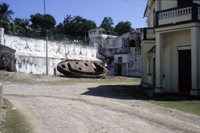 |
| An abandoned boat in downtown Jacmel. |
Saíntil remembered that citrus aphrodisiac, he told us, as we all lounged at a beachside bar and drank excellent 15-year-old Barbancourt rum and watched garbage wash up in the surf. Years ago, as a boy, he lived in one of the rural villages near here, before he moved away to Port-au-Prince. A rusted fishing boat had now been abandoned in the middle of Jacmel’s main waterfront street for more than a decade. And in Jacmel’s soft breeze, you smelled something less promising, something you can’t quite place: burning garbage? sweat? diesel exhaust? Simply the smell of things falling apart?
A little more relaxed and rum-soaked, we questioned Saíntil on his declaration that morning about Papa Doc’s mysticism. We asked if he really believed in voodoo.
“No,” he said resolutely, then thought for a moment: “I don’t personally believe in voodoo. For myself. But I do believe that voodoo exists for many people.”
Saíntil then switched topics to the national lottery and his method for picking the right numbers. Every night, Saíntil would try to dream of someone, and then play the number of letters in that person’s name. “I dreamed a name last night that I have not dreamed of since childhood,” Saíntil said. “Her name was Ghoslaine, and I loved her more than I ever loved anyone. I was so crazy in love that if she had asked me to kill someone, I would have done it. I wanted her so bad.”
We asked him what happened.
“She didn’t love me back. But that was all long ago.” Now, he said, he planned to play the number nine, for Ghoslaine, in the upcoming lottery.
Our 12-year-old guide reappeared in the bar and made another sales pitch for his sister, who now accompanied him. Instead of accepting, we set them up at a table and bought them both plates of chicken and rice.
At some point in the night, the bar ran out of rum, so Míchel wandered back to the room to get some of our own stash. When Míchel returned, he was visibly shaken. “Some kid on the beach just threatened me with a knife,” he said. The bartender mixed us more rum-and-Cokes with our own rum. Then, without so much as a wink, charged us full price.
•
The next day we were supposed to meet the people who grow the gourmet coffee I was to report on. The coffee was called Haitian Bleu and the project sounded good in theory. Funded by the U.S. Agency for International Development and administered by the Inter-American Institute for Cooperation in Agriculture, the project educates coffee farmers in Haiti’s remote highlands in the development, planting, pruning, and harvesting of gourmet coffee. The mission was twofold. IICA hoped to create a profitable cash crop for people who desperately needed money — Haiti is the poorest country in the Western Hemisphere, a place where 80 percent of the people live in absolute poverty on less than $2 a day. Also, because high-end shade coffee needs larger trees to thrive, an incentive was created to save what’s left of Haiti’s forests. IICA trains these farmers, who previously used crude slash-and-burn techniques, on how to grow high-quality coffee the correct way. To grow Haitian Bleu, you also have to plant trees.
More than 95 percent of the nation’s trees have been chopped or burnt down. Brown is now the color of Haiti’s mountainous spine. Not sepia or mahogany, just flat, sickly, heartbreaking brown. Mile after mile of slopes and valleys bake in the hot sun with no trees, no crops, no signs of life. In less than a century, Haiti’s interior has gone from a lush agricultural center — once prized by French colonialists for its coffee and sugar — to a desert, stripped bare of any timber that might possibly be burned for fuel or used to build shelter. You can see the skeletal remains carried down the roads in piles of dry dead twigs, carried on heads and backs. Essentially, the landscape is brown, the color of Haiti’s dry, suffering present.
Before I’d even been in Haiti two days, I’d already worked out the lead for my story in a notebook: “Yet even amid all the brown, a glimmer of hope for the country’s future may be seen in a new color — blue. More specifically, bleu, as in Haitian Bleu, a new variety of gourmet coffee bean now being grown by Haiti’s highland coffee farmers.”
Desir, one of IICA’s technical advisors, joined us, and Saíntil drove up the crumbling roads to Cap-Rouge, a coffee village high in the mountains. We kicked up a thick dust that left a film on our truck and clothes. Through several village markets, the hordes of people choked off the path; some poked their heads through our open windows and smiled. Little children shouted “blanc!” at the sight of our faces each time we passed through remote villages. One old woman reached in, touched my cheek with her knotted hand, and said, “Blanc.” We continued along, and it took over an hour to travel just six kilometers. We passed wide cemeteries on the sides of the road, with massive tombs marking the dead.
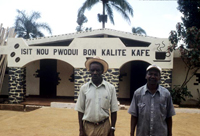 |
| The Cap-Rouge Cooperative: “Here we produce high quality coffee.” |
We arrived at Cap-Rouge and saw the words ISIT NOU PWODUI BON KALITE KAFE — “Here we produce high quality coffee” — painted on the wall of the co-op’s headquarters. This was where farmers for miles around brought their coffee beans for culling and sorting. Inside a dimly lit room, we were seated at a table with six farmers from the local co-op. We were told that 10,000 people from surrounding villages turned out when president Rene Preval visited Cap-Rouge. “Our president ate right here at this table,” said one of the men proudly, with Desir translating for us. “He promised to give us a secondary school.”
“Also,” Desir said, “your vice president, Mr. Albert Gore, came right out of the sky in his helicopter and landed right here.”
A woman appeared from the back room and poured coffee for everyone. The farmers watched with smiles on their faces as Kevin, Míchel, and I drank from tiny coffee cups. “It is not easy to process Haitian Bleu coffee,” Desir told us. “It takes a lot of time. But it is worth it.”
As he drank his coffee, Desir smiled for the first time. “Here is good people,” he said. “In Port-au-Prince, there is no good people.”
Later, the truck climbed higher up the mountain to another co-op site in the village of Fond Jean Noel. We watched a man with a bag of coffee on his back making what would be a three-hour walk down the mountain. In Haiti, just to get the coffee off the mountain can be a great accomplishment.
When we arrived in Fond Jean Noel, a dozen children trailed us toward the cooperative, where we met Gesper, its local vice president. Gesper showed us the storage room with dozens of bags of green coffee, the small cement yard where the beans were dried, and the pump-and-grind device used to remove the husks. “This pump was used by our president,” Gesper boasted.
On our way back down the mountain, we passed dirty brown rivers where men, women, and children were bathing, doing laundry, and relieving themselves only a few hundred yards upstream from the food stalls of an open-air market.
Kevin and Míchel requested another stop for drinks, and we sat on a cinder block half-wall in a little dirt-floored café and drank beer. Desir pointed out a huge white home across the street from the café, with a 10-foot gate, that belonged to an 80-year-old former Tontons Macoute. People walked sheepishly past, unsmiling, eyes glued to the gate.
Saíntil looked extremely worried and rubbed his foot through his broken sandal. He apparently had cut it the other day, and now he wiped sweat off his brow and kept saying over and over that he feared he had a fever. Kevin, Míchel, and I could plainly see that what Saíntil had was a very infected toe and offered him some antibiotic ointment.
But Saíntil insisted it was something much more dire. When he was a baby, a voodoo priest told his parents that Saíntil would never in his life have a fever like so many of the other sickly children in his village. The voodoo priest said he would only suffer one fever, late in life, as an older man. And this fever, the voodoo priest predicted, would be what finally killed Saíntil.
Saíntil reminded us that he was 49 years old. “That’s not old,” I said to console him. “Kevin and Míchel are older than that.” But what I knew from my research, and didn’t say, was that the median life expectancy of a Haitian man was 47.1 years.
•
At breakfast on Carnival day, we watched a parade of children in costumes pass by our hotel’s patio. Boys in purple tunics and fake swords danced in circles. Children with face paint and men with huge papier-mâché masks of dragons and lizards and spirits zigzagged down the road. A girl of about 5 danced on a stick that was levitated by a half dozen teenage boys while an older man pounded on a drum. Three men who’d literally doused themselves with motor oil as makeup and donned bull’s masks cracked long black whips in the middle of the street. After each performance, we placed gourdes in the dancers’ outstretched hands.
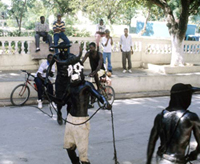 |
| Young men use motor oil and masks to portray bulls during Carnival. |
Later, we walked to the beachside bar and watched a young boy breaking the antennae off live baby lobsters and tossing them into a basket. He would have been locked up in Maine for bringing in shellfish that tiny, but here it was only a matter of a few dollars, and he cooked up some of the most tender lobster imaginable.
By that time Kevin was wearing a straw hat painted fluorescent green and orange that he’d purchased right off the head of a Haitian man for a simple glass of rum. One of the whip-carrying boys covered in motor oil entered the bar and gyrated in the middle of the dance floor.
Our bartender, the same one who’d charged us for our own rum the night before, told us that cruise ships would soon be returning to Jacmel, calling there as they did 30 years ago. When we scoffed and pointed out all the garbage and metal debris littering the harbor, the bartender said, “Cruise ships already call at Cap Haitien in the north. The cruise companies just don’t tell the Americans that they’re coming to Haiti. They say it’s a ‘secret Caribbean island.’”
Saíntil suggested we all go to a big cockfight that was happening on the outskirts of town and we agreed. As our truck approached the cockfight pit, more than 100 men peered out from beneath a thatched roof. “Here comes the blanc money,” said Míchel, under his breath, as we stepped out of the truck.
A fight had already begun. Under the thatched roof, men cradled roosters; each of the birds’ heads was covered with a sock or a rag so their talons wouldn’t be provoked. We bought tickets and squeezed past barefooted spectators who spilled off the wooden benches and leaned on one another to see two roosters tearing each other into a bloody mess. The fight took an agonizing 20 minutes, with the crowd cheering each time one of the cocks staggered backwards after a blow. Finally, one of them fell, and we watched money change hands.
Afterwards, in the sun, we watched a handler bring the losing rooster back to life by massaging it with a sponge. After kneading the poor, bloody, blinded animal for 10 minutes, it finally began twitching again — perhaps to fight another day.
In the second fight, we decided to put our money on the rooster of a nice, toothless old man we’d been sitting near. The old man’s son stood in the corner, sharpening the rooster’s claws with a rusty knife. Each of us handed the bookie 100 gourdes, and he scribbled something in pencil on a frayed sheet of paper.
What we soon learned about Haitian cockfighting was that arguing is nearly as important as the actual event. And so we waited, trying to decide if we wanted to continue to sunburn ourselves or squeeze under the little thatched roof. We watched a woman ladling a red homemade liquor out of a huge washtub. Nearly 100 men drank out of the same rusty metal cup. Míchel watched some others play a dice game on top of a makeshift table and figured out how the dealer teased the dice to his advantage. After Míchel won a dozen rolls in a row, the men changed the rules. After Míchel learned the new rules and won a few more rolls, the men told him he wasn’t allowed to play anymore.
Finally, as the smell of a hundred bodies stuffed in tight quarters under a sun-baked thatched roof reached its peak, the two cocks began fighting. But just as our rooster lunged for the other, our rooster’s handler — the nice, toothless old man — leaped into the ring and stood there screaming with outstretched hands. The whole pit erupted in Creole curses and yelling.
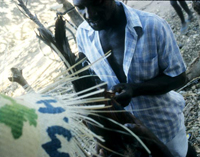 |
| Preparing the rooster’s talons for a cock fight. |
Saíntil translated the argument to us as if this sort of thing happened every day: The old man who jumped in the ring shouted that the opposing rooster was under a voodoo spell and that a zombie walked among the spectators at the cockfight. The old man declared that he was a powerful man and insisted upon standing in the ring to ward off the effects of the zombie. Of course the other men under the thatched roof didn’t like the idea of the old man standing in the middle of the cockfight, and they took issue.
Another half hour of arguing ensued, with a lot of shoving and pointing. Soon the fight was canceled. A young boy walked over and carefully counted bills and paid us back all of the money we’d bet. Judging from the tenor of the now-angry cockfight crowd, we decided to return to Jacmel before the next match started.
Later that evening, Kevin, Míchel, Saíntil, and I lounged on the patio at our hotel with rum-and-Cokes and listened to a ragtag band consisting of 10 men and only three instruments: a bongo, a homemade banjo, and a pair of maracas. The old man with the maracas, the band’s leader, danced and sang haunting Creole ballads, though he had no front teeth. His white belt, cinched tight against his frail waist, looked as though it could never keep his baggy pants from falling down. Later, drunker, the bandleader would fall down, backwards, over his own wooden chair. “Donnez quel que chose pour la musique” — “Give something for the music” — read a hand-drawn sign.
Kevin requested a popular song he only half remembered from his ’70s honeymoon. But when the band suddenly broke into the chorus “Duvalier, Duvalier,” nearly half the bar cleared out. The only one still dancing was a prostitute in a dirty brown dress. A dozen boys who loitered in the street kept tapping us on the shoulder, over the patio railing, with their palms out.
Our 12-year-old guide returned, again with his sister. Míchel told him to get lost, but Kevin had another idea. This boy was barefoot and for a couple days we’d all noticed how raw and injured his feet looked. Kevin took out four $20 bills, gave the boy one of them, and told him to go buy a pair of shoes with the money. “If you come back tomorrow at breakfast wearing a new pair of shoes,” he said, “I’ll give you the rest of the money.”
The next morning, over mango and coffee on the hotel patio, we saw the boy clomping across the square. He was wearing a brand-new, gigantic pair of what must have been size-13 basketball shoes. He could barely walk in them without tripping, and at one point he walked right out of them. But he was beaming and stomped up onto the patio and toward our table. He tapped Kevin on the shoulder and put his hand out. Kevin counted the bills into his hand.
•
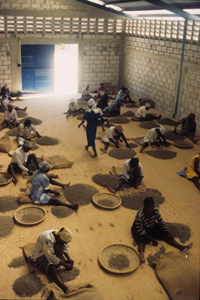 |
| Women sort coffee beans by size at the Hatian Bleu packinghouse. |
We returned to Port-au-Prince the same way we came. Along the way, we stopped at a place called Tombe Gateau, at the Haitian Bleu packinghouse, to meet with the cooperative’s executive director. As we entered the dim, cinderblock packing house, we saw two dozen women sitting on the ground, each with a basket and a pile of green coffee beans, sorting the beans by size with their hands. These beans would soon be placed in burlap sacks and sent to roasters in the United States. The director told us that Haitian Bleu would like to have its own roaster someday. “We want to have a roaster here by the time the cruise ships return to Jacmel,” he said.
As Saíntil finally approached the outskirts of Port-au-Prince, he took a right turn up a gravel road and cruised through narrow streets bordered by shacks. He parked in front of a tiny blue house — his house. At least a dozen children with no shirts and shoes crowded excitedly around the truck.
Saíntil brought us into his dark two-room house, introduced us to his wife, and showed us the ancient generator that gives his family four hours of electricity each night. At least two of these four hours are used to run a VCR that he proudly showed off — perhaps to watch a movie starring Shaquille O’Neal. Saíntil cornered Kevin, showed him an oily, unidentifiable part from his outmoded generator, and asked if Kevin would find a replacement when he returned to the United States.
Saíntil casually pointed out that his next-door neighbor was a voodoo priest. Above the house flew the telltale black, yellow, and red flag. We paid a visit to the voodoo priest and wandered through his temple. Murals of Christian saints, kings, and queens, and bloody pictures of dragons and swords graced the walls, while in a corner sat bongos and the altar, crowded with dusty dark bottles, wooden staffs, and a tiny 3-foot coffin. From the ceiling hung dozens of ripped plastic bags that read Carnation Evaporated Milk.
When we asked the priest if he could perform a ceremony for us, he refused. Then he said it would cost us several hundred dollars, and we refused. Saíntil explained that it would have been much too costly to prepare a voodoo feast for us, something he traditionally must do. The voodoo priest explained that this is why he rarely does ceremonies anymore.
Before we climbed back into the truck and continued on, Kevin, Míchel, and I unloaded our backpacks and gave away T-shirts, hats, pants, nearly everything to Saíntil’s children. Once back on the road, Saíntil sighed and told us he’d dreamed once again of Ghoslaine. “Whatever happened to her?” I asked.
“When I was 15, I was so madly in love with Ghoslaine that I went to the voodoo priest in my village to make her fall in love with me,” he said. The voodoo priest told Saíntil to bring him a brand-new handkerchief and a piece of candy and to pay him several gourdes, and the priest would cast a spell on Ghoslaine. “But I didn’t have any money, and so for weeks I scoured the dirt below the coffee trees for beans that the men had missed. And after many weeks, I had collected enough coffee to sell a sack and buy the candy and handkerchief and pay the priest.”
So Saíntil returned to the priest, who took his money, ground up a love powder that he sprinkled on the candy and the handkerchief, and gave Saíntil these instructions: Have Ghoslaine accept the piece of candy from you and eat it; then tap her three times with the handkerchief; then express your undying love. “After that,” Saíntil said, “the priest claimed she would be mine forever.”
Saíntil did exactly as the priest instructed. Ghoslaine ate the candy, and he playfully tapped her three times with the handkerchief. And he told Ghoslaine that he loved her more than anyone else in the world. “Then I waited for a week, for two weeks, for a month for her to return my love. But after that day, she simply stopped coming around. I didn’t know what to do. I went back to the voodoo priest, and he said that if I collected some more money, perhaps he could cast a more powerful spell.”
But as Saíntil went back out into coffee fields to collect more coffee beans, he discovered that Ghoslaine had pledged her love to someone else — his best friend, a clever young man who’d taught himself English and wooed Ghoslaine in a way that the Creole-speaking Saíntil could never match.
“After that, I didn’t believe in voodoo anymore,” Saíntil said. “That’s when I decided to run away from the country and move to Port-au-Prince. And more than everything else, I vowed to learn English.” So Saíntil has been living in the squalor that is Port-au-Prince since the days of Duvalier. Though he once heard that she lives in France, Saíntil said he never saw or heard from the beautiful Ghoslaine ever again.
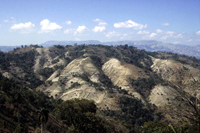 |
| The dry, treeless Haitian landscape. |
That night, we all drank more rum and lost our money in the casino in Petionville. We flew away from Port-au-Prince the next day, and all I could see stretching out from the chaotic city was mile after mile of brown mountains baking treeless in the hot Caribbean sun. When I got home, I used the glib lead I had worked out in my notebook: “Yet even amid all the brown, a glimmer of hope for the country’s future may be seen in a new color — blue. More specifically, bleu, as in Haitian Bleu, a new variety of gourmet coffee bean now being grown by Haiti’s highland coffee farmers.”
Ten years later, I now freely admit that this was typical lifestyle-magazine hyperbole. My excuse? I wanted badly to write a positive story about Haiti, quite possibly the only positive story about Haiti that would appear in the American press that year, or in any year. Looking back on my visit now, I realize how misguided my plans turned out to be. Anyone who reads the newspaper knows Haiti’s story. Just last week, there were massive riots over rising food prices and the government, once again, fell. The future of gourmet coffee and planting trees? These are the least of anyone’s concern. How asinine it was to think I’d jet in for a few days, jot down some notes, drive through the coffee fields, shoot some photos, scatter some tips and handouts among a few people, and scoot out with an uplifting narrative. Haitian Bleu — as most coffee buyers and tasters will tell you — is, at best, a mediocre coffee. The guy who wrote coffee reviews for the magazine of the “Coffee & Tea Lifestyle” called it “very inconsistent” and “limited.” Others say it leaves much too bitter an aftertaste.
In the end it is Saíntil’s story, with all its voodoo mysticism and strangeness, that’s the true one. And since Saíntil’s story is one about hope, and faith, and money, and love — and about the utter loss of all these things — his is the story that haunts me most when I think about Haiti. • 16 April 2008




